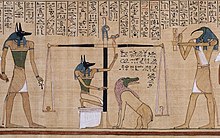Ammit
This article needs additional citations for verification. (March 2020) |
| Ammit in hieroglyphs | |||||||
|---|---|---|---|---|---|---|---|
ꜥm-mwt devourer of the dead | |||||||
 | |||||||
| Part of a series on |
| Ancient Egyptian religion |
|---|
 |
|
|

Ammit (/ˈæmɪt/; Ancient Egyptian: ꜥm-mwt, "devourer of the dead";[1] also rendered Ammut or Ahemait) was a demoness and goddess in ancient Egyptian religion with the forequarters of a lion, the hindquarters of a hippopotamus, and the head of a crocodile—the three largest "man-eating" animals known to ancient Egyptians. A funerary deity, her titles included "Devourer of the Dead", "Eater of Hearts", and "Great of Death".[3] Ammit lived near the scales of justice in Duat, the Egyptian underworld. In the Hall of Two Truths, Anubis weighed the heart of a person against the feather of Ma'at, the goddess of truth, which was depicted as an ostrich feather (the feather was often pictured in Ma'at's headdress). If the heart was judged to be not pure, Ammit would devour it, and the person undergoing judgment was not allowed to continue their voyage towards Osiris and immortality. Once Ammit swallowed the heart, the soul was believed to become restless forever; this was called "to die a second time". Ammit was also sometimes said to stand by a lake of fire. In some traditions, the unworthy hearts were cast into the fiery lake to be destroyed. Some scholars believe Ammit and the lake represent the same concept of destruction.
Ammit was not worshipped; instead, she embodied all that the Egyptians feared, threatening to bind them to eternal restlessness if they did not follow the principle of Ma'at.
See also[]
- Book of the Dead
- Chalkydri
References[]
- ^ a b Erman, Adolf; Grapow, Hermann (1926-1961) Wörterbuch der ägyptischen Sprache, Berlin: Akademie-Verlag, volume 1, page 184.9
- ^ "Egyptian Book of the Dead". Egyptartsite.com. Archived from the original on 2012-09-26. Retrieved 2012-08-18.
- ^ Hart, George (2005). The Routledge Dictionary of Egyptian Gods and Goddesses, Second Edition. Routledge. ISBN 978-0-203-02362-4.
External links[]
 Media related to Ammit at Wikimedia Commons
Media related to Ammit at Wikimedia Commons
- Egyptian demons
- Egyptian goddesses
- Book of the Dead
- Mythological hybrids
- Mythological lions
- Egyptian gods
- Justice goddesses
- Female legendary creatures
- Egyptian legendary creatures
- Mythological monsters
- Egyptian underworld
- Egyptian death gods